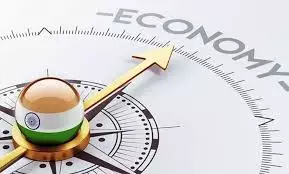India to be third-largest economy by FY31: S&P Global

Chennai: India is set to become the third-largest economy and transition to the upper-middle-income category by fiscal 2030–31 if forecast annual growth of 6.7 per cent is realized, finds S&P Global.
In the post-pandemic world, India has emerged as the fastest-growing large economy, with healthy medium-term prospects. In FY 2024, growth was on the upside at 8.2 per cent, exceeding the government’s earlier estimate of 7.3 per cent.
Increasing productivity should boost India’s growth, allowing the economy to expand 6.7 per cent on average till the end of the decade. According to S&P Global Market Intelligence projections, the size of the country’s nominal GDP would nearly double to over $7 trillion by fiscal 2030–31 from $3.6 trillion in fiscal 2023–24. This would make India the third-largest economy in the world, raising its share in global GDP from 3.6 per cent to 4.5 per cent and lifting its per-capita income to the upper-middle-income group.
The private sector needs to take the lead in achieving a balanced and sustainable lift in the investment cycle. The continuation of structural reforms to facilitate business transactions and improve the logistics sector will support private-sector investment, making growth less dependent on public capital expenditure.
The India Composite PMI Output Index, compiled by S&P Global Market Intelligence, reached one of the highest levels in nearly 14 years, supported by favorable economic conditions, strong demand, capacity expansion, increased new work intake, and productivity gains.
The internalization of India’s capital markets, supported by the inclusion of Indian government bonds in major emerging market indexes, is an encouraging first step. Indian equity markets will remain active by regional standards, assisted by a supportive domestic regulatory environment.
It will be critical for India to lead global governance on technologies such as generative AI, which can be harnessed for economic growth. India can aim to replicate the success of the digital infrastructure public-private partnership model and S&P Global Ratings data shows significant public investment commitments into its AI sector.
India is experiencing a multidimensional, interlinked economic and energy transition. Its growth story will rely on executing an energy strategy that balances security, affordability, and adoption of material net-zero technologies.
In the next decade, India is prepared to adopt techniques and reforms to address climate change, ensure food supplies, and improve farm incomes.
Beyond the domestic landscape, India must capitalize on a 7,500-km coastline using investment, trade, and geopolitical strategies to augment its commerce. More than 90 per cent of India’s trade is conducted via sea, comparable to the trade dynamics of South Korea, China, and Vietnam.

